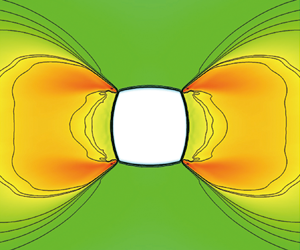Article contents
Converging near-elliptic shock waves
Published online by Cambridge University Press: 21 December 2020
Abstract

This paper characterizes the geometry of converging near-elliptic shock waves at a Mach number of 6. The converging shocks are produced by elliptic conical surfaces with shapes made up from adjacent straight generators, each deflected a constant angle from the free-stream direction. Combined shock tunnel experiments and numerical analyses are conducted to depict the evolution of the converging shock waves for several elliptic entry aspect ratios  $AR$s (i.e. the ratio of the major axis to the minor axis). It is revealed that the deviation from axial symmetry is amplified as the shock front approaches the centreline, which results in different shock interaction types compared with the axisymmetric case. Three typical shock interaction types are classified depending on various ARs. For a small AR, faster shock strengthening in the major plane dominates, although a Mach reflection (type A) that resembles the axisymmetric flow field is formed. However, for a sufficiently large AR, the shock strengthening is eventually terminated by the intersection of the weaker shocks in the minor plane owing to their smaller off-centre distances, which results in a regular reflection (type B). Between these two interaction patterns, there is a critical AR for which both the shock fronts in the major and minor planes intersect at the centreline coincidentally, and this critical intersection (type C) exhibits an extreme case of a shock front converging to a singular point. This study indicates that deviation from axial symmetry affects the evolution of the shock structures in converging flow.
$AR$s (i.e. the ratio of the major axis to the minor axis). It is revealed that the deviation from axial symmetry is amplified as the shock front approaches the centreline, which results in different shock interaction types compared with the axisymmetric case. Three typical shock interaction types are classified depending on various ARs. For a small AR, faster shock strengthening in the major plane dominates, although a Mach reflection (type A) that resembles the axisymmetric flow field is formed. However, for a sufficiently large AR, the shock strengthening is eventually terminated by the intersection of the weaker shocks in the minor plane owing to their smaller off-centre distances, which results in a regular reflection (type B). Between these two interaction patterns, there is a critical AR for which both the shock fronts in the major and minor planes intersect at the centreline coincidentally, and this critical intersection (type C) exhibits an extreme case of a shock front converging to a singular point. This study indicates that deviation from axial symmetry affects the evolution of the shock structures in converging flow.
JFM classification
- Type
- JFM Papers
- Information
- Copyright
- © The Author(s), 2020. Published by Cambridge University Press
References
REFERENCES
- 7
- Cited by





